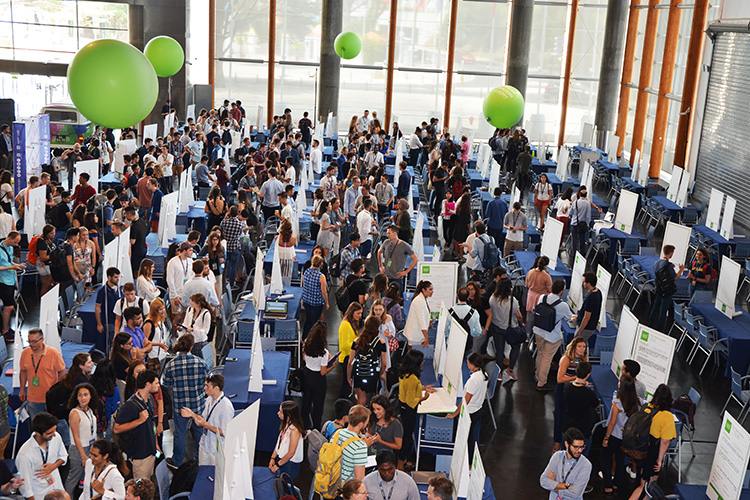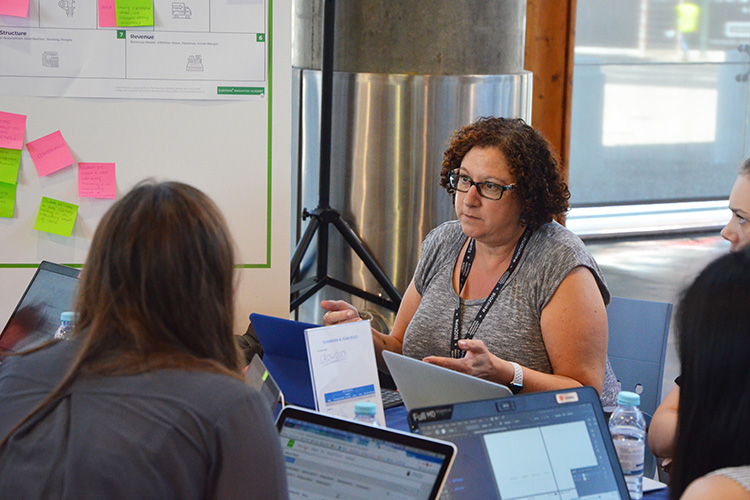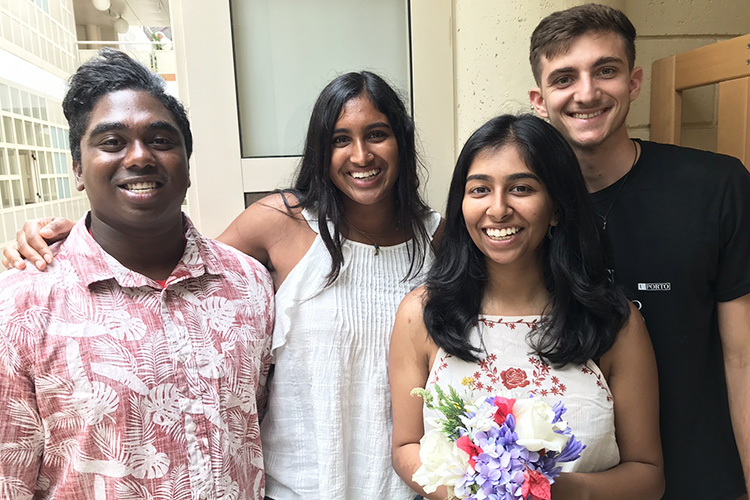Berkeley Method gets students thinking like entrepreneurs
Leadership boot camp gives Berkeley's contingent an edge at the annual European Innovation Academy — and in life

October 25, 2018
It was a stressor of an assignment for some 400 students at the European Innovation Academy (EIA) in Cascais, Portugal: Form diverse teams of five and, in just 15 days, create startups to pitch to a panel of investors, in hopes of launching the next Instagram or Airbnb. A few students, blanching in the face the world’s largest extreme entrepreneurship program, packed for home.
The clock began ticking for the rest, and the trendy Estoril Congress Center grew chaotic. At the Idea Expo, college students from 70 nations had three hours to shop, speed dating-style, for teammates and real-world problems to solve.
“Fifteen days is enough time to build a startup from scratch,” said Anni Sinijarv, the non-profit EIA’s Estonian CEO and co-founder, confidently observing the drama. “The top 10 teams wind up on the big stage and pitch to venture capitalists who sometimes want to invest right away. Americans compare it to ‘Shark Tank,’ only focused on students.”

Berkeley student Peach Nashed works on her startup team’s business plan at the European Innovation Academy. (UC Berkeley photo by Gretchen Kell)
During the arduous, July 14 to Aug. 2 event, many of the 80 teams — each with a chief executive, business, marketing, technology and design officer — split up and rearranged several times in pursuit of the right team chemistry. Students’ startup ideas also changed like the wind.
To help, 50 experts in marketing, intellectual property, hardware, software, pitching and design — half of them from Silicon Valley — were flown in as mentors. So were 34 lecturers, including corporate leaders from Fiat Chrysler, Google and Amazon. EIA online tools — an Extreme Acceleration Playbook and even a chatbot dog named Growby — kept students organized.
But UC Berkeley’s 56 participants arrived with an edge — their own method for the madness. It would help them wind up on five of the top 10 teams in the EIA Pitching Carousel and on three more teams awarded provisional patents and trademarks.
At a Berkeley-only leadership camp held 200 miles away in Porto just beforehand, they’d learned the Berkeley Method of Entrepreneurship. A game-based, inductive learning approach developed and launched at Berkeley in 2012 — and taught worldwide today — it helps individuals develop the mindset and behaviors of a successful entrepreneurial leader.

Porto, Portugal, was the setting for the 2018 summer Berkeley Method of Entrepreneurship boot camp, which preceded the EIA. (UC Berkeley photo by Gretchen Kell)
According to new findings by a Canadian research team that studied the Berkeley boot campers in Porto, they made substantial gains in skills vital to entrepreneurial success — creativity, leadership and teamwork — in just one week.
Such gain required pain. More like a boot camp, the leadership week “is designed to feel really uncomfortable,” admits Ken Singer, managing director of the UC Berkeley College of Engineering’s Sutardja Center for Entrepreneurship and Technology (SCET) and co-inventor of the Berkeley Method. “But it forces students to look for the information and tools they need to build a company and a team.”
“I’m OK with being uncomfortable, because of what I’m learning,” said Berkeley participant Britney Cooper in Porto. “I’m struggling, and it’s the best thing ever.”
Method for a mindset
The Berkeley Method has radical roots dating back to 2005, when Ikhlaq Sidhu was recruited to Berkeley’s faculty to launch what’s known today as SCET. At the time, Berkeley Engineering was known for training hard-core engineers, not entrepreneurs, and had no formal entrepreneurship courses.
Then-Dean Richard Newton, both an engineer and entrepreneur, “believed engineers shouldn’t be so narrow; they shouldn’t be reduced to a calculator,” says Sidhu, an industry veteran who’d previously founded the Technology Entrepreneur Center at the University of Illinois, Urbana-Champaign. “They need to learn more skills to change the world — like how to communicate well, work well in teams, show initiative, be adaptable.”

Ikhlaq Sidhu, faculty director and chief scientist of the UC Berkeley Sutardja Center for Entrepreneurship and Technology, is a co-founder of the Berkeley Method of Entrepreneurship. He won a major international award this year for his contributions to entrepreneurship pedagogy and innovative teaching methods. (Photo courtesy of SCET)
To give students a business perspective, he invited Silicon Valley CEOs who’d founded companies including Netscape, Google, Yahoo!, Cloudera and Wired to be guest lecturers. But it was the CEOs themselves, not the lectures, that intrigued Sidhu and his students.
“They had behaviors, a mindset, ways of seeing the world,” explains Sidhu, SCET’s chief scientist and Industrial Engineering and Operations Research (IEOR) Emerging Area Professor. “I started to believe these were the most important things, more important than logic and skill. They were dynamic and clever, and you could see why their companies grew.”
Meanwhile, Singer, a serial entrepreneur hired in 2012 to manage and grow SCET, was creating popular entrepreneurship and technology classes, like the competition-based Challenge Labs that pair interdisciplinary student teams with industry clients. The Berkeley alumnus also was sharing the soft skills he’d mastered — leading, listening, collaborating, hiring the right people and rebounding from failure.
“We weren’t just teaching STEM (science, engineering, technology and math) at SCET, but introducing psychology and culture to entrepreneurship — and it was unique to Berkeley,” says SInger. “We were building something different, as a public university, that was working for our population.”

Ken Singer (left), managing director of the UC Berkeley Sutardja Center for Entrepreneurship and Technology and lead instructor for the Berkeley leadership week, co-created the Berkeley Method with Sidhu. Next to him is Danielle Vivo, SCET program manager. (UC Berkeley photo by Gretchen Kell)
In 2014, he and Sidhu co-authored a research paper that established a progressive new teaching and learning approach: the Berkeley Method of Entrepreneurship. It outlined 10 behavioral patterns they’d observed in successful CEOs and proposed specific games to elicit them in budding entrepreneurs.
“It wasn’t enough for students to learn about these behaviors through lectures, case studies and books,” says Singer. “They needed to experience them to really internalize the lessons.”
“While students worked on start-up ideas,” adds Sidhu, “we’d place stress into their environment to bring out behaviors — good and bad — and then have them reflect on what they’d tried, what they might want to try next with their teams, their customers.”
Today, the Berkeley Method is taught year-round at Berkeley in SCET boot camps, Challenge Labs and even technical settings like the campus’s Data-X Lab. The curriculum is shared in dozens of countries, too, through SCET’s Global Venture Lab, and at workshops for professionals in large companies including Google, Apple and Facebook.

Berkeley’s leadership team for the Berkeley Summer Abroad program in Portugal, from left: Stephen Torres, Bailey Farren, Moor Xu, Ken Singer and Danielle Vivo. (Photo courtesy of SCET)
For five summers in Europe, a Berkeley Method boot camp, taught by Singer, has preceded the EIA. The two offerings connect as a six-unit, four-week Berkeley Summer Abroad experience. Students get one week to learn the method, then three more to put it to work under extreme conditions — in a foreign country, on international teams and with a tight deadline.
“In my opinion, the Berkeley Method is the best way to prepare students for the EIA,” says Sinijarv. “Every year, Berkeley students perform with very high results. First, the method changes their mindset, and second, it gives Berkeley students, who already are competitive, an intensity, an ability to do even more.”
Let the games begin
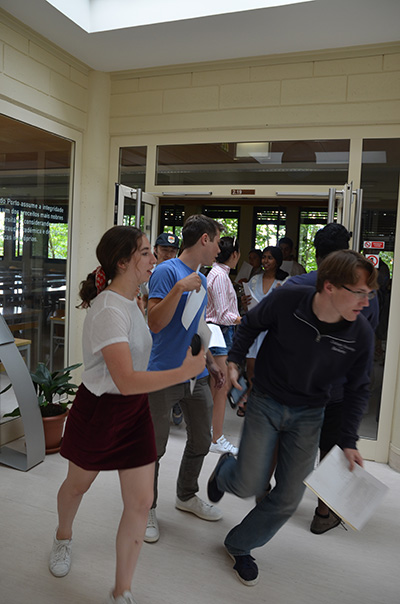
Teams of Berkeley students dash out of the University of Porto to compete in a Berkeley leadership week challenge. (UC Berkeley photo by Gretchen Kell)
It’s 9 a.m. on July 9, Day 1 of the Berkeley-only leadership camp at the University of Porto, and Singer deliberately is a no-show. A note from him, taped to a blackboard, contains the students’ first assignment: Memorize each other’s names in 45 minutes.
Pandemonium ensues. Then, one of the 56 students loudly coaxes everyone into a circle to say their names and a fun fact: “I’m Adam. I was born with six toes.” “I’m Peach, and I’m a certified spray tanner.” “Hi, I’m Samir. I know each country’s capital.”
Other outspoken students’ ideas also get a try — name tags, alphabetical order, small groups. Several participants disengage. At 9:45, Singer appears, and three students actually know every name. But that wasn’t the point, he explains. This was an exercise in self-organization, an eventuality in the chaos of entrepreneurship.
He asks: Did anyone rebel against the leaders? he asks. Or query the quiet ones?
“In America, the loudest wins. But in some countries, silence is golden,” Singer tells the group. “This is the week that shows tough people that others are of value, too. If you want to be a leader, keep everyone engaged.”

A University of Porto student dance and folk music group, Sirigaitas, performed at a reception held by the Portuguese university for Berkeley students, staff and instructors. (Photo by Gretchen Kell)
In the days that follow, Singer assigns games that push student teams to communicate, trust each other, set priorities, take risks, face terrible odds and be resilient. All the games “trigger you and make you respond,” says Cooper.
Singer wants the games’ details kept secret, for the sake of future participants. But the goal of them, he says, is “to help students discover the skills they can offer a team, how they interact with others and what part of themselves they need to fix to do a better job.”
“Team formation is 99 percent of this program,” he tells the class. “If you wind up joining or forming the wrong team at the EIA, it will be as painful as #$&%*! Choose wisely.”
In-class surveys also expose students’ strengths and weaknesses: Of the seven deadly sins, which are your Top 2? (Most circle pride and gluttony). What is your superpower? Are you a convergent or divergent thinker? Logical or creative? Do you have a fixed or a growth mindset?
Midweek, Meighan Visco, a living architecture and green infrastructure major, says the games “are bringing out different parts of my personality, making me a better teammate.” She wows her peers with a personal business website Singer assigns as homework; later, at the EIA, she’s the design officer on a Top 10 team.
As for her leadership abilities, “I used to think I was pretty good,” she adds. “But I’m learning that leadership isn’t telling people what to do; it’s understanding people and helping them realize their own capabilities.”

Meighan Visco, a UC Berkeley student (third from left), with members of her winning startup team, which made it into the Top 10 at the European Innovation Academy. (Photo courtesy of EIA)
Participant Steven Chan, a 2018 Berkeley graduate with engineering and physics degrees, says the boot camp “is like a hazing week. It really takes a toll on people.” But he adds he’s grateful “to be forced to map my inner self.”
Among the things he’s learning, he says, are that his fear of failure makes him risk averse, and that he needs to be “more confident in my own skin, to speak up and believe in myself.”
“During leadership week, students are confronted by their greatest strengths and weaknesses, enabling them to form teams with a well-rounded set of skills,” says Berkeley rhetoric and cognitive science major Bailey Farren, a 2017 participant hired as a 2018 EIA ambassador. “Teams without the right skills tend to fail more. A lot more. And after this first brutal week, Berkeley students learn to create teams that win.”
Lessons for life
Britney Cooper says friends consider her “the most introverted person they know.” The 2018 Berkeley graduate, with a B.A. in rhetoric, loves reading books and quiet contemplation, plans to get a Ph.D. and actively battles social anxiety.
But Cooper is also ambitious and had secretly dreamed of being a leader. So, she emptied her bank account to attend the four-week program in Portugal. “I had blind spots in business, leadership and extrovert performance skills, and I knew going outside my wheelhouse would challenge me,” says Cooper. “It was so worth it, and I’d do it all over again.”
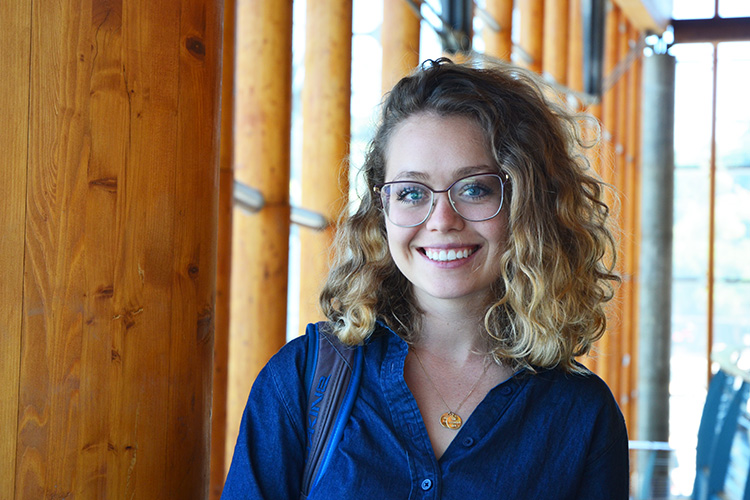
“I proved to myself that I can step up,” says Britney Cooper, a 2018 Berkeley graduate, of what she learned as a Berkeley leadership week and European Innovation Academy participant. (UC Berkeley photo by Gretchen Kell)
Today, Cooper plans to be an entrepreneur, as well as a professor of science and technology studies. And she’s already working at a Bay Area startup, VectorCare, energized by her role as customer success and account manager and grateful to have the Berkeley Method in her toolkit.
“My company culture is like a wolf pack, and I’m using the tools from leadership week to not just adapt, but to thrive there. The first two weeks, the CEO put me through chaos to see if I could find my own way,” she admits. “I survived because I had the mindset that the boot camp and EIA gave me. It’s helping me learn quickly and add so much value.”
The Berkeley Method’s effect on Cooper isn’t surprising to Simon Taggar, a professor of organization behavior and human resources management at the Lazaridis School of Business and Economics in Ontario, Canada. He and fellow researchers Anne Dorumath and Nicole Coviello traveled to Portugal to study the impact of Singer’s program.
When comparing the Berkeley students’ confidence in their individual creativity, leadership and teamwork before and after the one-week training, “there generally were increases — in some cases substantial increases,” he says.
The team, which recently released its data, found that the highest jump was in the students’ confidence to lead. On a scale of 1 to 5, the average score of 1.91 at the week’s start rose to 4.22 as the week ended, showing students became more than twice as confident, “and that’s an incredible increase,” says Taggar. “That this happens in just a week is surprising to me. I think that’s excellent. In our economies, we need this method to maintain a competitive advantage in the field of innovation.”

“This truly is a remarkable program if you go into it with a growth mentality,” says Berkeley alumnus Steven Chan, holding a silicon wafer with solar cells that he fabricated in one of Berkeley’s labs. He says the Berkeley Method prepared him for his new job at a startup in the solar industry. (UC Berkeley photo by Jeremy Snowden)
Cooper says she’s realized that being a CEO doesn’t suit her strengths, but that another key leadership role on a startup team is her best match — “influencing the direction of the team from within, by processing and extrapolating information for it.”
Chan reached a similar conclusion; he’s now working as a project engineer/project manager at New Equity Energy, a startup. He says he can “deal with chaos and stress, which is inevitable in the solar industry,” because of his summer experience.
As for Visco, she says she’s learned “what’s possible in the world of marketing and creating new things, what to look for in a business concept and how to validate whether an idea is a good one or not. And I now realize what parts of building a company I like — pitching, marketing and customer validation.”
Singer and Sidhu consider these success stories. And should any of their Berkeley Method proteges abandon the entrepreneurial path, says Sidhu, “we’re not just teaching people to be entrepreneurs. We’re giving them life skills.”
“And the better I know myself,” adds Cooper, “the more I can contribute to the world.”

